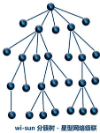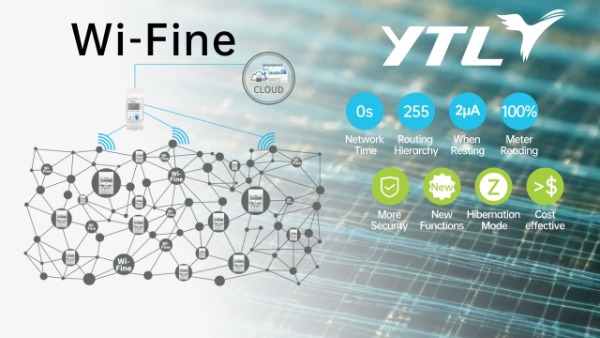1. Modulation Rate
Wi-Fine Communication: (G)FSK 50Kbps~500Kbps; LoRa 5Kbps~37.5Kbps
Wi-Sun Communication: (G)FSK 50Kbps~300Kbps; QPSK/OFDM planned.
2. Protocol Overview
Wi-Fine Communication: A lightweight, distributed wireless mobile self-organizing network protocol family designed for low-cost, low-power, and mobile devices.Using a universal RF chip, open hardware design, implemented in assembly language, pursuing the ultimate network experience, with the best cost performance, can meet the needs of the vast majority of IoT applications.
Wi-Sun communication: Physical layer: IEEE 802.15.4G MAC layer: IEEE 802.15.4/4E Network layer: 6LowPAN/IPv6 Routing protocol: Network layer RPL "standard" protocol stack, not much innovation, not pursuing performance, just saying it works.3. Network
3.Topology
 Wi-Fine Communication: Nodes can establish connections with all neighboring nodes, fully leveraging the redundant connections between network nodes. The number of routes is a geometric multiple of Wi-Sun networks, making the network highly robust with multi-path concurrency, and network throughput can exceed the physical layer wireless rate.
Wi-Fine Communication: Nodes can establish connections with all neighboring nodes, fully leveraging the redundant connections between network nodes. The number of routes is a geometric multiple of Wi-Sun networks, making the network highly robust with multi-path concurrency, and network throughput can exceed the physical layer wireless rate.
 Wi-Sun Communication: The network only achieves basic connectivity between nodes, without fully utilizing the redundant connections between network nodes. The network has poor robustness and very low throughput.
Wi-Sun Communication: The network only achieves basic connectivity between nodes, without fully utilizing the redundant connections between network nodes. The network has poor robustness and very low throughput.
4. Routing Protocol
Wi-Fine Communication: A distributed mobile network where the routing protocol is implemented at the link layer. No network routing establishment process is required, as each node is independently responsible for its own routing. Both upstream and downstream traffic utilize the same routing method, and the root node is not the center of the network. The discovery and maintenance of routes occur simultaneously during data transmission, eliminating the need for additional overhead. Nodes will maintain as many dynamic real-time routes as possible and can send packets in parallel through multi-hop routing.Nodes can move freely within the network, and data flows can smoothly switch between old and new routes.
Wi-Sun communication: A centralized network that uses the RPL protocol at the network layer, requiring the establishment of network routes. Each node needs to find a certain node to serve as its parent node and report the parent node information to the network/root node. The root node calculates the path to reach each node, using source routing for downstream traffic. Routing updates and maintenance are independent of the data transmission process and only look for new routes when routing fails. Routes cannot be updated during data transmission.The node position needs to be fixed.
5. Routing Levels
Wi-Fine Communication: Distributed routing, the number of routing levels is limited by the length of the message. The maintenance overhead of routing is independent of the number of levels and nodes. In practical applications, it can support 255 levels of routing, with a large network coverage.
Wi-Sun Communication: Due to the use of source routing for downstream, the number of routing levels is limited by the length of the message. The maintenance overhead of routing will rapidly increase with the increase of levels and number of nodes.In actual applications, only below 10 levels are used.
6. Collision Algorithm
 Wi-Fine Communication: Designed based on a multi-point to multi-point concurrent model, independent of signal strength detection. It automatically perceives and calculates based on the number of simultaneously transmitting nodes. With 2 to 256 concurrent nodes in adjacent point situations, the bandwidth utilization efficiency reaches over 90%. The collision algorithm is closely integrated with routing protocols. During collision processing, information such as routing and broadcasting is exchanged, sensitive to routing changes, and nodes can move arbitrarily.
Wi-Fine Communication: Designed based on a multi-point to multi-point concurrent model, independent of signal strength detection. It automatically perceives and calculates based on the number of simultaneously transmitting nodes. With 2 to 256 concurrent nodes in adjacent point situations, the bandwidth utilization efficiency reaches over 90%. The collision algorithm is closely integrated with routing protocols. During collision processing, information such as routing and broadcasting is exchanged, sensitive to routing changes, and nodes can move arbitrarily.
Wi-Sun communication: IEEE 802.15.4/4E (CSMA-CA), based on a star topology for point-to-multipoint communication, does not receive new messages while attempting to send a message and does not sense the number of concurrent nodes. The effective bandwidth utilization decreases sharply with the increase of concurrent nodes, and may even lead to transmission failure. The MAC layer collision algorithm is independent of routing protocols and does not exchange routing information during collision resolution.
7.Network Scale
Wi-Fine Communication: Distributed network, node hardware resources expenditure is basically independent of the number of nodes. There can be multiple root/gateway nodes in the network, and the network scale can be infinitely expanded.
Wi-Sun Communication: FFD requires a large amount of resources to store routing tables, with a maximum capacity of 5000 points in a network.
8.Sleep Mode:
Wi-Fine Communication: Multiple sleep modes, all nodes can sleep, can be awakened and queried in single-point or whole-network manner.
Wi-Sun communication: Routing nodes cannot sleep, only leaf nodes can sleep, with CSL (wake-up)/RIT (query) methods.
9.Reliability
Wi-Fine communication: Unicast with 5 handshakes, broadcast with 4 handshakes, no sleep to ensure 100% reliable transmission.
Wi-Sun communication: Does not guarantee reliability, overseas practical application of lighting control cases, success rate only around 85%.
10.Full-network collection
Wi-Fine communication: Routing establishment and data collection of all nodes in the entire network can be completed within seconds.On a network with a topology of up to thousands of nodes, the data collection time is around 10 seconds.
Wi-Sun Communication: Not supported.
11. Throughput
Wi-Fine Communication: In a single physical channel network, the throughput can reach 90% of the physical bandwidth. The throughput of multiple physical channels in parallel is not limited by the physical bandwidth and can be infinitely expanded.
Wi-Sun Communication: Due to not pursuing performance, the network throughput is far lower than the physical bandwidth.
12. Transmission Delay
Wi-Fine Communication: The routing protocol has minimal overhead, with only the physical layer transmission delay required for each forwarding level, resulting in very small network delay.
Wi-Sun communication: network clustering/layer design, forwarding messages between clusters results in low efficiency and large network delay.
13. Packet sending frequency
Wi-Fine communication: several to tens of milliseconds.
Wi-Sun communication: around 10 seconds.
14. Network establishment time
Wi-Fine communication: the network does not require an establishment process, data transmission can immediately start after the network is powered on. Routing information can be continuously optimized and updated during data transmission, making it ideal for low power consumption and high real-time application scenarios.
Wi-Sun Communication: Before the network can be used, the RPL routing protocol needs to be used to establish a routing table from the gateway to all nodes, and each node also needs to find its parent node. Additionally, with the network clustering design, the entire process is very time-consuming. Depending on the network scale, it generally takes from several tens of minutes to several hours.
15.OTA
Wi-Fine Communication: All nodes in the network can undergo OTA simultaneously, utilizing a reliable distribution method. The time taken is basically independent of the number of root nodes, and it only takes a few seconds to achieve OTA for all nodes.
Wi-Sun Communication: The network throughput is very low and the OTA time is astonishingly long. According to on-site testing, it takes tens of minutes for OTA with 30 nodes. If the number of nodes is increased, OTA becomes impractical.

 English
English 中文简体
中文简体





.jpg?imageView2/2/w/500/h/500/format/png/q/100)





.png?imageView2/2/w/500/h/500/format/png/q/100)


